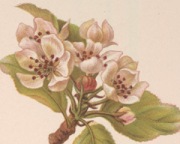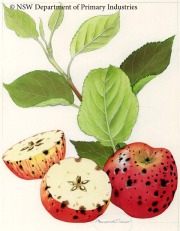The history of the apple in Maine, and throughout New England, began with the first colonization by Europeans. Sieur de Monts was said to have planted fruit trees on his property on St. Croix Island in 1604 and Baron St. Castine had an orchard in Castine in the 1660s. According to tradition, in the town of York, Maine, an apple tree, brought over from England in a tub and planted on the property of Thomas Gorges (deputy-governor of Maine from 1640 to 1643) still bears fruit. Even the names of some Maine towns reflect their agricultural history; Old Orchard Beach supposedly housed a group of fruit trees planted early in its settlement, some lasting until 1770. Apple trees have been in Maine since the early seventeenth century, but orcharding did not take off for almost two hundred years after their introduction (Day, Maine Ag).
During the state’s rapid population growth in the late eighteenth and early nineteenth centuries, settlers from Massachusetts and New Hampshire poured in, bringing with them the demand for apples and apple cider. Early orchards were mostly groups of seedling trees, the farmers taking a chance on genetics and hoping to find a good variety for cider, baking, storage, or fresh eating in the fall. The desirable apple trees were usually moved from the seedling group to a permanent orchard when they were five or six years old. Day states that “most apple trees set prior to 1830 were seedlings and grew old and died without ever a cut from the grafter’s knife” (pg 206). Before the establishment of big nurseries and seed companies, Maine farmers had to scatter their apple seeds and pray for a usable variety they could graft and propagate.
It is believed that Dr. Benjamin Vaughan and his brother Charles, from the Kennebec Valley, launched one of the first commercial nurseries in Maine about 1795. By 1804, another entrepreneur, Ephraim Goodale from Orrington, published the first printed catalog of Maine nurseries. By this time, orcharding was building itself up in the state. The Pomological Society had not yet been established, but apples were just coming into high demand, especially for their use in cider. Most seedling apples could be pressed into cider which could be kept all winter. Farmers allowed cider to naturally ferment into a potent drink that became the stock of many New Englander’s diets; England had beer, New England had apple cider.
It was not until the temperance movement overtook Maine that apple orchards began to decline. Between 1825 and 1840, the push to prohibit drinking meant that apples, which were mostly used to make the dangerous cider, fell out of popular demand. The severe winter of 1831 and 1832 also damaged the apple crop, which took several years to recover. But the orchards soon bounced back, and the apple business developed quickly and strongly from the 1840s to the outbreak of the Civil War. By the Reconstruction era, orcharding in Maine was in full swing and the state bursting with fruit and continuing to grow (Day, Maine Ag). Maine orchardists were selling their profitable crop at home, they were also exporting their surplus all over the growing United States, South America, and Europe, especially England and Germany.















Leave a comment
Comments feed for this article